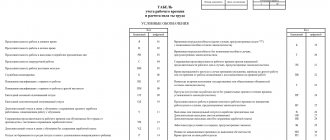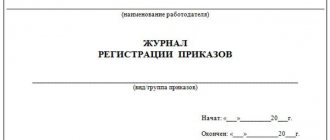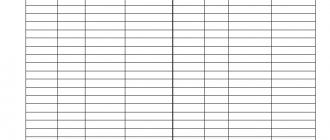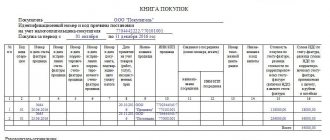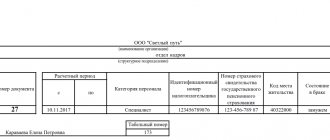Employees' arrival and departure times can be controlled using various methods. The most common is keeping a time log.
Dear readers! The article talks about typical ways to resolve legal issues, but each case is individual. If you want to find out how to solve your particular problem , contact a consultant:
8 (800) 700 95 53
APPLICATIONS AND CALLS ARE ACCEPTED 24/7 and 7 days a week.
It's fast and FREE !
In addition to information about being late and leaving work early, it provides initial data on the time actually worked by each employee, which is necessary for drawing up time sheets and calculating wages. Keeping records of working hours is mandatory for enterprises and organizations under Article 91 of the Labor Code of the Russian Federation.
What it is
The journal is not a standardized document and does not have a single approved form. The most common templates can be found online or purchased at a stationery store. An enterprise can develop and approve its own journal form.
To determine the time worked by an employee, you will need the following information:
- employee data that allows him to be uniquely identified (full name, position, structural unit);
- information about the beginning and end of the working day, confirmed by the personal signature of the employee and the controller;
- information about absence from the workplace, indicating the reason, with the signature of the employee or responsible person (for example, about being sent on a local business trip);
- notes on business trips, time off, agreed upon postponements of the start of the working day and other agreements between the employer and employee.
The journal can be kept in a notebook or formed by filling out daily accounting sheets that are filed or stapled. Individual sheets must have the necessary protection against forgery (date, stamp and signature of the responsible person).
What is it needed for
Recording working time in the form of a log may be required when resolving controversial situations, confirming lateness to work and to verify the legality of a citizen’s absence from work. The work time log is the primary document for calculating wages for hourly wages.
To impose a disciplinary sanction for tardiness or absenteeism, an entry in the logbook is not enough, but if the employee refuses to explain, it can be used when drawing up a report of tardiness or absence from work.
The use of the journal must be provided for by the labor regulations; its form and maintenance procedure must also be enshrined in the internal documents of the organization.
Is it necessary
The Labor Code (Article 91) requires the employer to keep records of working hours. Controlling work time has two main goals:
- prevention of exceeding established work time limits, including during irregular working hours;
- identifying cases of violation of labor discipline.
The Code does not oblige the enterprise to keep a logbook. To calculate wages, a time sheet is required, which is drawn up on the basis of a journal, administrative documents and employee explanations.
In accordance with the Law “On Archival Affairs,” the Ministry of Culture indirectly established the need to maintain an accounting journal - through approving the storage periods for a standard archival document generated as a result of the activities of government agencies, local governments and organizations.
This provision was recognized by the Supreme Arbitration Court as not contradicting the current legislation regarding the obligation of commercial organizations to store the listed documents, including time sheets and logs of hours worked (decision of the Supreme Arbitration Court 14589/11 of 02.21.12).
Rules for maintaining and registering employee working time logs
A time log is a document that indicates when employees come to the enterprise and when they leave it.
A time log is a document that becomes necessary when the number of company employees becomes significant enough that management or responsible employees no longer have the ability to record their appearance “by eye.” Then the document takes on this function.
It is worth noting that the legislation does not stipulate that it is mandatory for enterprises with a large number of personnel. Also, there is no standard form for it; the requirements are limited to those existing in office work in general.
Therefore, enterprises themselves can set the details for their own accounting journals in accordance with the needs of a particular company.
The accounting journal can serve to solve the following tasks:
- determining the amount of time worked by staff with irregular working hours;
- registration of cases of lateness and early departure from work;
- occupation of shelter during overtime work.
Thus, using this document, it is possible to accurately record the time that all employees spend in their place.
In addition, the journal can be referred to if disputes arise between an employer and an employee regarding certain issues related to working time. Likewise, it is permissible to refer to this journal in court, with the caveat that it must be maintained in the correct manner. If violations are discovered, it may not be accepted as evidence.
Magazine form
Each organization can approve its own ledger format for recording arrivals and departures from work. Mandatory journal details:
- full name of the organization, including legal form;
- start and end dates of maintenance (filled in upon actual);
- data of the responsible person;
- number of pages filed.
All pages inside the book must be numbered, and the cover must indicate the total number of pages.
You can download the excel form.
Columns that can be included in the journal for each working day:
- FULL NAME.;
- department, position;
- time of arrival at work, signatures of the employee and the controller;
- time of leaving work, signatures of the employee and the controller;
- comments about the reasons for lateness and absence;
- service columns used to fill out the timesheet (number of hours worked, etc.).
The person responsible for maintaining the log is required to ensure that the employee is identified using a regular or electronic pass or identification document.
The responsibility for keeping a log should be assigned to an employee (for example, a security guard or watchman) by order of the organization. For each month, one journal is created for the entire organization or its structural unit.
Journal of employee arrivals and departures (working hours)
Journal of employee arrivals and departures (working hours)
- used to register the arrival and departure of employees. The data entered in the journal may be the basis for filling out a Time Sheet.
An example of filling out the main section of the journal:
The magazine includes additional materials:
- Section III. Employment contract Chapter 13. Termination of the employment contract (excerpts)
- Section IV. Working hours Chapter 15. General provisions, Chapter 16. Working hours
- Section VIII. Work schedule. Labor discipline. Article 189. Labor discipline and work schedule
The employer is required to keep time records
actually worked by each employee. (Labor Code of the Russian Federation, Article 91).
Work time
- the time during which the employee, in accordance with the internal labor regulations and the terms of the employment contract, must perform labor duties, as well as other periods of time that, in accordance with this Code, other federal laws and other regulatory legal acts of the Russian Federation, relate to working time .
The procedure for calculating the norm of working time for certain calendar periods (month, quarter, year), depending on the established duration of working time per week, is determined by the federal executive body exercising the functions of developing state policy and legal regulation in the field of labor. (Labor Code of the Russian Federation, Article 91).
Time tracking
is organized for the purposes of:
- ensuring control over the timely attendance of workers and employees at work, identifying late and no-shows;
- monitoring the presence of personnel at workplaces during working hours, as well as the timely departure and arrival of employees during the lunch break;
- recording the timely departure of employees from work at the end of the working day;
- accounting for actually worked time, downtime, illness, vacations and other forms of use of working time;
- registration of absenteeism.
According to Art. 81, paragraph 6 of the Labor Code of the Russian Federation, an employment contract can be terminated by the employer in case of absenteeism
, that is, absence from the workplace without good reason throughout the entire working day (shift), regardless of its duration, as well as in the case of absence from the workplace without good reason for more than
four hours in a row
during the working day (shift).
Who in the organization should keep track of working hours?
Each specific organization decides this issue on its own based on the specifics of its activities. The obligation to keep timesheets can be specified in an employee’s employment contract, job description, or assigned to him by a separate order for his main activity.
For violation of the obligation to record working time, the guilty officials bear administrative liability.
, imposed by the Federal Labor Inspectorate.
Before starting to work with the Journal, you must fill out the title page and certification. Be sure to enter the seal number in the appropriate line; without this, the Journal is not considered sealed.
Source: https://www.HR-OK.ru/e-store/office/5150/
Order
An internal document of the organization (order) establishes the responsibility of employees for entering correct information into the working time log, as well as the responsibilities of the controller for checking the information and confirming it.
The form of the journal can be approved either together with the responsibilities for filling it out, or as a separate document.
Document preparation
When registering a working time log, you must follow the rules for registering all other logs maintained at the enterprise - in accordance with the rules for preparing such documents.
Example graph of the main section of a magazine
Requirements
The requirements for registering the working hours of employees in a company are as follows:
- The name of the magazine should appear on the cover;
- The title page must indicate the full name of the company and its branch to which the magazine belongs;
- Here you must indicate the start date of making entries in the journal. And after the last entry is made, the end date for journaling is set;
- The person responsible for maintaining the document is indicated on the last flyleaf.
The time sheet and its maintenance are described in this video:
Filling
The log is filled out by the responsible employee; all data must be entered strictly in the columns intended for them. If a signature box is provided, the employee signing must be familiar with the entry.
Only the employee responsible for its maintenance should have access to the log.
You can download the journal form for free here.
Sample of filling out a working time log
General rules
When maintaining a journal, you must adhere to the following rules:
- Entries in the journal should only be made in pen; there should be no entries made in pencil;
- If there is a need to correct an entry, the incorrect one is crossed out and the correct option is written on top. You should not use a concealer;
- All entries must be made in such a way that they are written legibly and accurately;
- All entries must be in a row, there should be no empty lines.
Nuances for special professions
Since there is no unified form for the magazine, and its maintenance is not provided for by law, all the nuances of maintenance for various professions (eg contract military personnel, educational psychologist, etc.) will depend on the form of the developed magazine and what information is in it reflected.
Frequency of filling
The frequency of filling out the journal depends on what data is entered into this document, but in any case the rule must be followed: “filling out the journal after the fact.” This means that entries are made in the journal directly when an employee appears at his workplace or when he leaves.
Stitching
The accounting journal must be prepared like all other journals, that is, numbered and stitched. The numbering must be continuous, starting from the first sheet. Then the magazine is stitched, and the firmware is sealed with a rectangle of paper, which indicates the number of sheets stitched.
Who issues
Responsibility for maintaining the log rests with the HR department. An employee of this department must be responsible for preparing a properly completed log before the start of the calendar month, processing data on time present at work, and verifying information about the validity of absence.
An employee who is constantly present at the entrance to the organization (watchman, security guard, secretary, etc.) can ensure the maintenance of the accounting book.
The job description of the person maintaining the accounting log must indicate the obligation to fill out and responsibility for incorrect data. It is necessary to instruct the watchman or security guard on what to do if an employee refuses to fill out the log or tries to enter false data.
Confirmation of information about absence from work, including sick leave and vacations, should be assigned to the personnel department.
Constant monitoring and random checking of data entered in the journal must be carried out by the responsible employee of the HR department personally or, if there is an electronic control system, using data on passage using an electronic pass.
The requirement to log in daily is communicated to all employees against signature when the order to implement working time tracking is approved.
If accounting is mandatory based on the organization’s labor regulations, it is communicated to personnel upon hiring by familiarizing themselves with the VTR rules.
How to fill out a magazine, sample
Employee data is entered into the journal by the responsible employee at the beginning of the month.
Example of a daily log sheet:
Columns (1) and (2) are filled out by the employee responsible for maintaining the journal (HR representative or secretary). Columns (3) – (7) are filled in by the employee. A personal signature must be used to confirm both the time of arrival and the time of leaving work.
In the “Notes” section, the employee enters information about local business trips, agreed upon early departure, or reason for being late. The controller daily confirms the compliance of information on arrival and departure times for each employee.
No later than at the end of the month, the personnel department calculates working hours in column (9) to generate a monthly accounting sheet; in column (10) you can enter information about vacation, the employee’s explanation for being late, etc.
When deciding on the storage period for the journal, you should focus on the statute of limitations for labor disputes and the storage period for archives of primary documentation. In 2010, the Ministry of Culture approved the storage periods for archival documents. According to this document, time sheets and log books must be kept for 5 years.
Employee time log. 2020 sample
An employee time log is in demand in most enterprises that have hired personnel. This document is not mandatory, but its presence allows you to resolve many issues and prevent the development of situations that are unpleasant for both parties in the labor relationship.
Why do you need a document?
Before answering this question, let us dwell in more detail on the actual concept of “working time”. As you know, a standard work week lasts 40 hours – 8 hours a day. During this period, the employee must perform the labor functions assigned to him by the employer in full accordance with the labor (or collective) agreement and regulations adopted at the enterprise.
Wages are calculated based on hours worked. All hours that the employee spent at work in excess of this legally established norm are paid at a double rate. But if an employee does not work enough time, management has the right to apply certain sanctions to him.
To resolve issues related to the establishment of actually worked hours, a working time log is being developed. Information in the journal is entered for each employee of the organization separately.
Thus, the document is necessary for both parties to the labor relationship, since it performs several functions at once:
- Solves the problem of monitoring the time that each employee of the enterprise spends at his workplace.
- Serves as the basis for calculating wages (especially if the organization accepts hourly wages).
- It is an aid to management in the matter of organizing discipline at the enterprise.
Sometimes a document can become a substantiating reason for imposing a disciplinary sanction on an employee who has violated work regulations.
How to count working hours
There are several methods for recording working hours:
- Standard daily - used if employees come to and leave work at the same time.
- With weekly accounting, the daily parameter loses its significance, since employees are not required to “sit out” hours, but must fulfill a certain work rate during the week, including time (for example, on one day an employee works six hours, on another - ten).
- The summarized method is optimal in production or with a flexible work schedule. Typically, data is recorded here based on the results of the month, but sometimes longer periods are also covered (the maximum is one year).
How to Journal
The journal can be kept in electronic and paper form. Electronic journaling is possible in different formats, depending on what software the employer uses.
There are budget forms, in which almost all actions are carried out manually, and there are more complex, “advanced”, fully automated systems that transfer information directly to accounting programs (usually access to such software occurs only if the employee has a key).
In any case, the electronic form of the document is convenient, because allows you to save time, effort and makes it possible to easily control the working time of employees based on indicators such as unauthorized absences, overtime, sick leave, etc.
If the journal is kept in paper form, then all its sheets must be numbered, fastened together using a “harsh” thread (a stapler cannot be used), then the number of sheets must be marked on the last page, stamped (provided that the seal is used in the work of the organization) and sign the employee responsible for maintaining the journal. In the future, you should autograph each completed page of the document.
The journal is usually kept by a human resources specialist or an accounting employee. Depending on this, the storage location of the document during its validity period is determined.
The responsible employee is responsible not only for the accuracy of the information entered in the journal, but also for its timely and complete transfer to specialists for payroll, as well as for performing all other necessary actions.
The magazine does not have a uniform design standard. This means that representatives of each organization can form it in any form or according to a template developed within the company and approved by management, as well as the trade union body (if there is one).
Like the design of the magazine, its structure and text are completely left to the employees of the enterprise.
It is recommended to write on the title page:
- Company name;
- journal opening date and end date (entered after the document is closed);
- indicate the employee responsible for its maintenance;
- if the organization has a list of cases, then you need to provide a link to the journal index in accordance with this accounting document.
The main part of the journal is best presented in the form of a table in which the following data must be entered:
- serial number of the employee, his full name and position;
- date, time of arrival and departure, as well as information about lateness (the exact number in minutes and hours);
- information about absenteeism - yes/no;
- the amount of total time worked (minus absences on personal business);
- employee signature.
If required, the table can be supplemented with other data (for example, about why the employee left the workplace during the day).
Features for hazardous working conditions
The working time log for harmful (difficult, dangerous) working conditions must reflect the restrictions on working hours established by Article 92 of the Labor Code of the Russian Federation. The reduction of working hours is determined in the collective agreement and in the internal rules of the enterprise.
These documents must reflect:
- list of professions (staff positions) with hazardous conditions;
- type of work with such conditions;
- duration of working time in hours established for employees.
Hazardous work must be reflected in the agreement with each employee whose work duties are performed under such conditions.
Due to the pronounced seasonality of work or the peculiarities of the technological process, summarized accounting of time worked over a period of 3 months to a year can be used.
The law defines a special storage period for primary documentation for recording work time in hazardous industries - it is 75 years for both the report card and the journal. For such enterprises, it is advisable to conclude an agreement with a specialized archival institution.
It is recommended to keep a working time log at an enterprise of any form of ownership. It allows you to track the time actually worked by employees and can be used to confirm attendance at work. The document should be stored together with the unified report card for at least 5 years.
Time log: sample and filling rules
The relationship between employee and employer includes many nuances, one of which is compliance with the work schedule. Even during employment, the future employee understands that at the right time and during the designated hours he must deal with his direct responsibilities.
Legislative framework and purposes of recording time worked
Compliance with the Labor Code of the Russian Federation prevents controversial situations surrounding working hours as much as possible. The time during which an employee must perform work duties as regulated by the employment contract and internal regulations is called working time. Organizations are required to keep records of the hours each employee actually works.
The law protects both parties to an employment contract.
From the employee's point of view, management does not have the right to force employees to work hours beyond the state limit. A normal working week should not exceed 40 hours. Overtime work also has a limit - no more than 4 hours for two days in a row and 120 hours per year.


